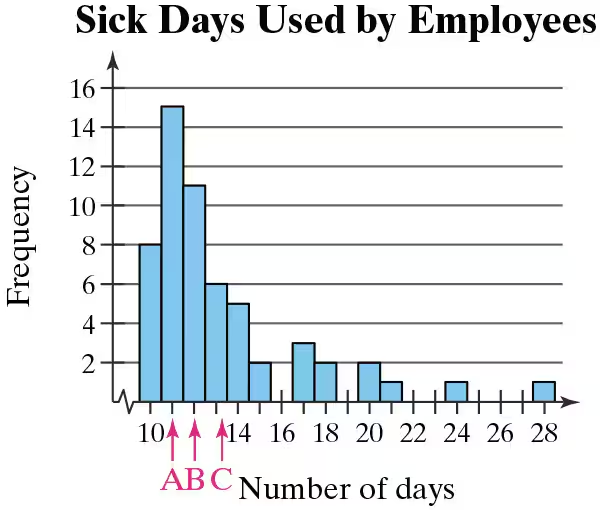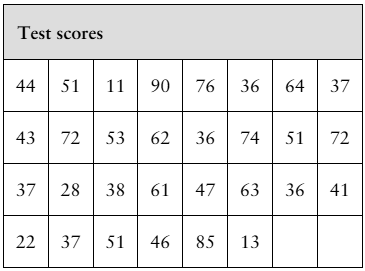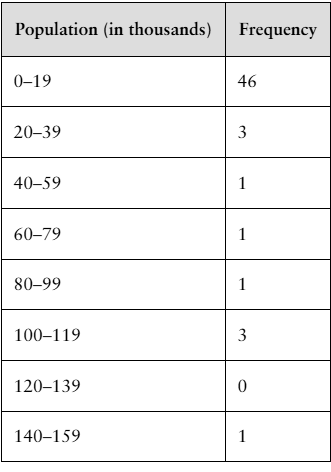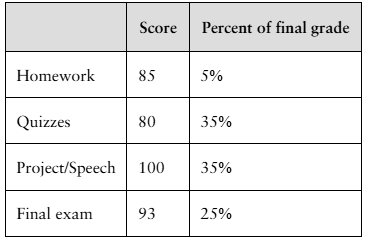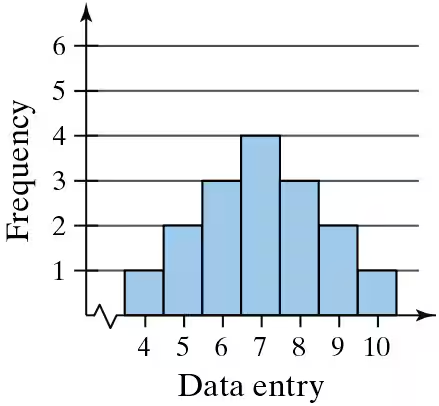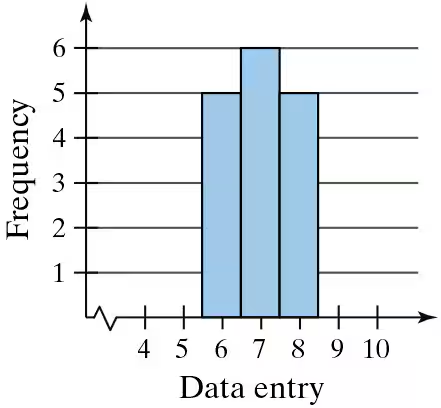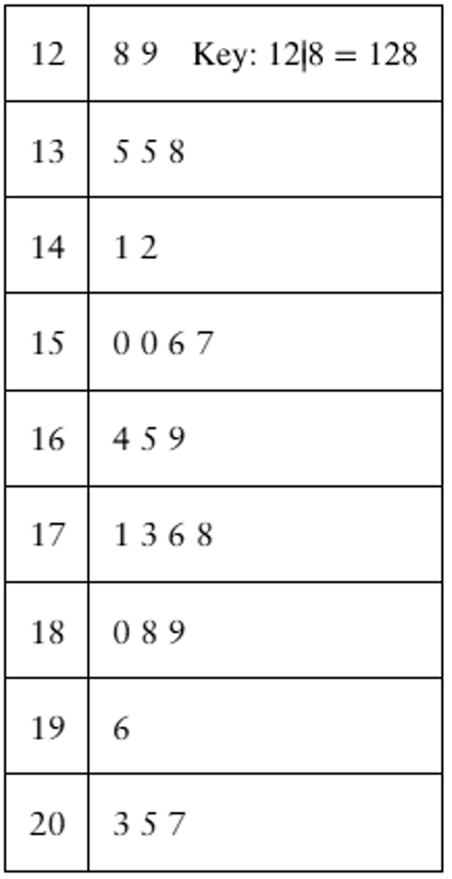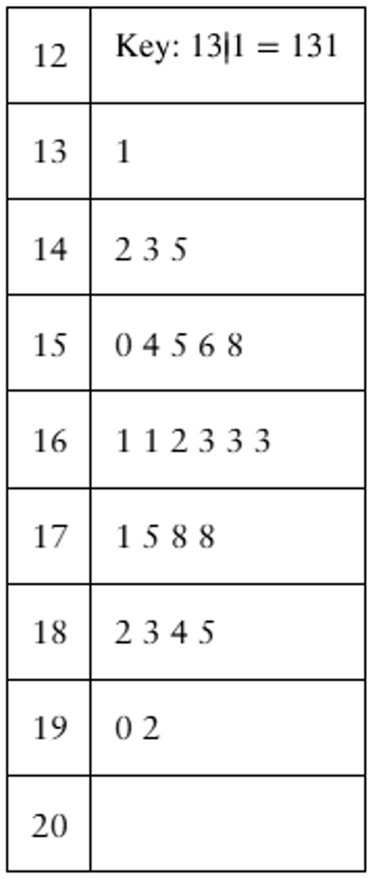 Back
BackProblem 2.3.59
Graphical Analysis In Exercises 59 and 60, the letters A, B, and C are marked on the horizontal axis. Describe the shape of the data. Then determine which is the mean, which is the median, and which is the mode. Justify your answers.
Problem 2.3.65a
Extending Concepts
Data Analysis Students in an experimental psychology class did research on depression as a sign of stress. A test was administered to a sample of 30 students. The scores are shown in the table at the left.
a. Find the mean and the median of the data.
Problem 2.3.17
Using and Interpreting Concepts
Finding and Discussing the Mean, Median, and Mode In Exercises 17–34, find the mean, the median, and the mode of the data, if possible. If any measure cannot be found or does not represent the center of the data, explain why.
College Credits The number of credits being taken by a sample of 14 full-time college students for a semester
12 14 16 15 13 14 15
18 16 16 12 16 15 17
Problem 2.3.46
Finding a Weighted Mean In Exercises 41– 46, find the weighted mean of the data.
Grades A student receives the grades shown below, with an A worth 4 points, a B worth 3 points, a C worth 2 points, and a D worth 1 point. What is the student’s grade point average?
Problem 2.3.48
Grades In Exercise 46, one of the student’s B grades gets changed to an A. What is the student’s new grade point average?
Problem 2.3.50
Finding the Mean of a Frequency Distribution In Exercises 49–52, approximate the mean of the frequency distribution.
Social Media The average daily amounts of time (in minutes) spent on Snapchat
Problem 2.3.52
Finding the Mean of a Frequency Distribution In Exercises 49–52, approximate the mean of the frequency distribution.
Populations The populations (in thousands) of the counties in Montana in 2019 (Source: U.S. Census Bureau)
Problem 2.3.66a
Extending Concepts
Trimmed Mean To find the 10% trimmed mean of a data set, order the data, delete the lowest 10% of the entries and the highest 10% of the entries, and find the mean of the remaining entries.
a. Find the 10% trimmed mean for the data in Exercise 65.
Problem 2.3.66b
Extending Concepts
Trimmed Mean To find the 10% trimmed mean of a data set, order the data, delete the lowest 10% of the entries and the highest 10% of the entries, and find the mean of the remaining entries.
b. Compare the four measures of central tendency, including the midrange.
Problem 2.3.66c
Extending Concepts
Trimmed Mean To find the 10% trimmed mean of a data set, order the data, delete the lowest 10% of the entries and the highest 10% of the entries, and find the mean of the remaining entries.
c. What is the benefit of using a trimmed mean versus using a mean found using all data entries? Explain your reasoning.
Problem 2.3.55
Identifying the Shape of a Distribution In Exercises 53–56, construct a frequency distribution and a frequency histogram for the data set using the indicated number of classes. Describe the shape of the histogram as symmetric, uniform, negatively skewed, positively skewed, or none of these.
Heights of Males
Number of classes: 5
Data set: The heights (to the nearest inch) of 30 males
67 76 69 68 72 68 65 63 75 69
66 72 67 66 69 73 64 62 71 73
68 72 71 65 69 66 74 72 68 69
Problem 2.3.39
In Exercises 37– 40, without performing any calculations, determine which measure of central tendency best represents the graphed data. Explain your reasoning.
Problem 2.3.41
Finding a Weighted Mean In Exercises 41– 46, find the weighted mean of the data.
Final Grade The scores and their percents of the final grade for a statistics student are shown below. What is the student’s mean score?
Problem 2.3.44
Finding a Weighted Mean In Exercises 41– 46, find the weighted mean of the data.
Credit Card Balance For the month of October, a credit card has a balance of $115.63 for 12 days, $637.19 for 6 days, $1225.06 for 7 days, $0 for 2 days, and $34.88 for 4 days. What is the account’s mean daily balance for October?
Problem 2.3.19
Using and Interpreting Concepts
Finding and Discussing the Mean, Median, and Mode In Exercises 17–34, find the mean, the median, and the mode of the data, if possible. If any measure cannot be found or does not represent the center of the data, explain why.
Video Durations The lengths (in minutes) of seven educational videos from the Public Broadcasting Service (PBS) (Source: PBS)
83 67 90 55 56 119 52
Problem 2.4.22c
Graphical Analysis In Exercises 21–24, you are asked to compare three data sets.
(c) Estimate the sample standard deviations. Then determine how close each of your estimates is by finding the sample standard deviations.
i.
ii.
iii.
Problem 2.4.1
Building Basic Skills and Vocabulary
Explain how to find the range of a data set. What is an advantage of using the range as a measure of variation? What is a disadvantage?
Problem 2.4.6
Building Basic Skills and Vocabulary
Given a data set, how do you know whether to calculate σ or s?
Problem 2.4.9
Using and Interpreting Concepts
Finding the Range of a Data Set In Exercises 9 and 10, find the range of the data set represented by the graph.
Problem 2.4.11a
Archaeology The depths (in inches) at which 10 artifacts are found are listed.
20.7 24.8 30.5 26.2 36.0 34.3 30.3 29.5 27.0 38.5
a. Find the range of the data set.
Problem 2.4.13
In Exercises 13 and 14, find the range, mean, variance, and standard deviation of the population data set.
Drunk Driving The number of alcohol-impaired crash fatalities (in thousands) per year from 2010 through 2019 (Source: National Highway Traffic Safety Administration)
10.1 9.9 10.3 10.1 9.9 10.3 11.0 10.9 10.7 10.1
Problem 2.4.16
Finding Sample Statistics In Exercises 15 and 16, find the range, mean, variance, and standard deviation of the sample data set.
Pregnancy Durations The durations (in days) of pregnancies for a random sample of pregnant people
277 291 295 280 268 278 291
277 282 279 296 285 269 293
267 281 286 269 264 299 275
Problem 2.4.18
Estimating Standard Deviation Both data sets shown in the stem-and-leaf plots have a mean of 165. One has a standard deviation of 16, and the other has a standard deviation of 24. By looking at the stem-and-leaf plots, which is which? Explain your reasoning.
Problem 2.4.20
Salary Offers You are applying for jobs at two companies. Company C offers starting salaries with μ = $59,000 and σ = $1500. Company D offers starting salaries with μ = $59,000 and σ = $1000. From which company are you more likely to get an offer of $62,000 or more? Explain your reasoning.
Problem 2.4.42
Estimating the Sample Mean and Standard Deviation for Grouped Data In Exercises 41–44, make a frequency distribution for the data. Then use the table to estimate the sample mean and the sample standard deviation of the data set.
Weekly Study Hours The distribution of the number of hours that a random sample of college students study per week is shown in the pie chart. Use 32 as the midpoint for “30+ hours.”
Problem 2.4.36
Using Chebychev’s Theorem Old Faithful is a famous geyser at Yellowstone National Park. From a sample with n = 100, the mean interval between Old Faithful’s eruptions is 101.56 minutes and the standard deviation is 42.69 minutes. Using Chebychev’s Theorem, determine at least how many of the intervals lasted between 16.18 minutes and 186.94 minutes. (Adapted from Geyser Times)
Problem 2.4.39
Finding the Sample Mean and Standard Deviation for Grouped Data In Exercises 39 and 40, make a frequency distribution for the data. Then use the table to find the sample mean and the sample standard deviation of the data set.
3 3 5 3 8 0 3 9 6 6 7 1 6 3 2 6 9 1 8 5 0 2 3 4 9
5 8 1 9 7 6 9 6 7 0 6 3 8 6 8 7 3 8 9 3 7 2 4 4 1
Problem 2.4.25
Constructing Data Sets In Exercises 25–28, construct a data set that has the given statistics.
N = 6
μ = 5
σ ≈ 2
Problem 2.4.28
Constructing Data Sets In Exercises 25–28, construct a data set that has the given statistics.
n = 6
x̄ = 7
s ≈ 2
Problem 2.4.31a
Using the Empirical Rule In Exercises 29–34, use the Empirical Rule.
Use the sample statistics from Exercise 29 and assume the number of vehicles in the sample is 75.
a. Estimate the number of vehicles whose speeds are between 63 miles per hour and 71 miles per hour.

